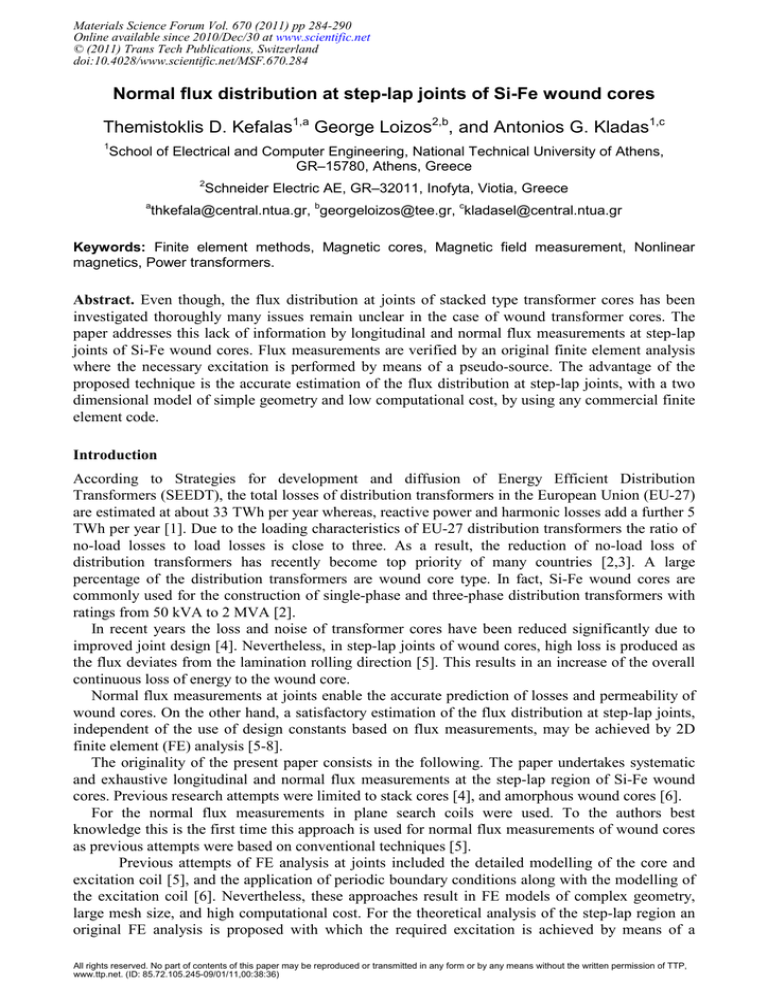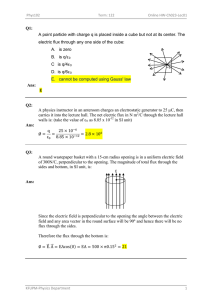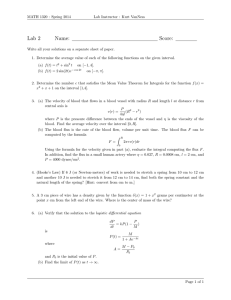
Materials Science Forum Vol. 670 (2011) pp 284-290
Online available since 2010/Dec/30 at www.scientific.net
© (2011) Trans Tech Publications, Switzerland
doi:10.4028/www.scientific.net/MSF.670.284
Normal flux distribution at step-lap joints of Si-Fe wound cores
Themistoklis D. Kefalas1,a George Loizos2,b, and Antonios G. Kladas1,c
1
School of Electrical and Computer Engineering, National Technical University of Athens,
GR–15780, Athens, Greece
2
Schneider Electric AE, GR–32011, Inofyta, Viotia, Greece
a
thkefala@central.ntua.gr, bgeorgeloizos@tee.gr, ckladasel@central.ntua.gr
Keywords: Finite element methods, Magnetic cores, Magnetic field measurement, Nonlinear
magnetics, Power transformers.
Abstract. Even though, the flux distribution at joints of stacked type transformer cores has been
investigated thoroughly many issues remain unclear in the case of wound transformer cores. The
paper addresses this lack of information by longitudinal and normal flux measurements at step-lap
joints of Si-Fe wound cores. Flux measurements are verified by an original finite element analysis
where the necessary excitation is performed by means of a pseudo-source. The advantage of the
proposed technique is the accurate estimation of the flux distribution at step-lap joints, with a two
dimensional model of simple geometry and low computational cost, by using any commercial finite
element code.
Introduction
According to Strategies for development and diffusion of Energy Efficient Distribution
Transformers (SEEDT), the total losses of distribution transformers in the European Union (EU-27)
are estimated at about 33 TWh per year whereas, reactive power and harmonic losses add a further 5
TWh per year [1]. Due to the loading characteristics of EU-27 distribution transformers the ratio of
no-load losses to load losses is close to three. As a result, the reduction of no-load loss of
distribution transformers has recently become top priority of many countries [2,3]. A large
percentage of the distribution transformers are wound core type. In fact, Si-Fe wound cores are
commonly used for the construction of single-phase and three-phase distribution transformers with
ratings from 50 kVA to 2 MVA [2].
In recent years the loss and noise of transformer cores have been reduced significantly due to
improved joint design [4]. Nevertheless, in step-lap joints of wound cores, high loss is produced as
the flux deviates from the lamination rolling direction [5]. This results in an increase of the overall
continuous loss of energy to the wound core.
Normal flux measurements at joints enable the accurate prediction of losses and permeability of
wound cores. On the other hand, a satisfactory estimation of the flux distribution at step-lap joints,
independent of the use of design constants based on flux measurements, may be achieved by 2D
finite element (FE) analysis [5-8].
The originality of the present paper consists in the following. The paper undertakes systematic
and exhaustive longitudinal and normal flux measurements at the step-lap region of Si-Fe wound
cores. Previous research attempts were limited to stack cores [4], and amorphous wound cores [6].
For the normal flux measurements in plane search coils were used. To the authors best
knowledge this is the first time this approach is used for normal flux measurements of wound cores
as previous attempts were based on conventional techniques [5].
Previous attempts of FE analysis at joints included the detailed modelling of the core and
excitation coil [5], and the application of periodic boundary conditions along with the modelling of
the excitation coil [6]. Nevertheless, these approaches result in FE models of complex geometry,
large mesh size, and high computational cost. For the theoretical analysis of the step-lap region an
original FE analysis is proposed with which the required excitation is achieved by means of a
All rights reserved. No part of contents of this paper may be reproduced or transmitted in any form or by any means without the written permission of TTP,
www.ttp.net. (ID: 85.72.105.245-09/01/11,00:38:36)
Materials Science Forum Vol. 670
285
pseudo-source i.e., by the use of properly defined boundary conditions. In this fashion the geometry
of the 2D FE model is simplified and the computational cost is minimised. The specific technique
can be implemented with any commercial FE package e.g., ANSYS, MagNet, or FEMM. To the
authors’ best knowledge, this is the first time this technique is formulated and applied in the case of
step-lap joints of wound cores.
Longitudinal and Normal Flux Measurements at Step-Lap Joints
The experimental analysis is based on a single-phase wound core of high permeability steel with a
nominal loss of 0.72 W / kg at 1.5 T, 50 Hz (Fig. 1). A 15 turns primary coil was supplied from a
230 V, 50 Hz single-phase supply via an autotransformer in order to magnetise the core from 1.1 T
to 1.7 T.
The longitudinal flux was measured using two turns search coils (17A to 17G and 18A to 18C)
wound around the total width of the 17th and 18th sheet (Fig. 2). The search coils arrangement was
such, that the flux density distribution of the step-lap joints could be determined accurately.
Fig. 1. Wound core geometry.
Fig. 2. Cross-section of step-lap joints and search coils arrangement for longitudinal flux
measurements (not to scale).
286
Applied Electromagnetic Engineering
Fig. 3. Cross-section of step-lap joints and search coils arrangement for normal flux measurements
(not to scale).
Fig. 4. Application of the pseudo-source in the 2D FE model of the step-lap joints region.
The normal flux in the step-lap joints was measured using single turn search coils whose plane
was parallel to the sheet plane (Fig 3). These were positioned so that a full record could be obtained
of the flux flowing normal to the plane of the 17th and 18th sheet.
Solderable enamelled copper wire 0.1 mm in diameter was used for the search coils. The overall
loss of the core did not change noticeably after the coils were wound in position, showing that the
flux distribution did not change much due to the search coils being introduced.
The voltages induced in the search coils were captured by directly connecting the search coils
into a NI6143 DAQ card inputs. Necessary calculations and analysis of the captured data were
carried out using LabVIEW software [9-11].
Description of the Pseudo-Source Technique and 2D FE Analysis
The pseudo-source technique consists in the application of certain boundary conditions for the
excitation of the step-lap joints rather than model current regions, i.e., the excitation coil. The
technique is illustrated in Fig. 4, where B p is the mean peak flux density, k = 5 is the number of
steel sheets, c sf = 0.965 is the lamination stacking factor, and Lth = 0.27 mm is the lamination
thickness.
For simplicity Az1 is set to zero. Also in the case of 2D FE analysis, Neumann boundary
condition is a natural boundary condition and therefore there is no need to be explicitly imposed.
Materials Science Forum Vol. 670
287
The geometry of the 2D FE model of the step-lap joints region is shown in Fig. 2. The ratio of
the length to the height, of the FE model representing the step-lap joints, is almost 70. This is due to
the lamination thickness (0.27 mm) and the relatively large gap and lap length.
The authors made use of the commercial package ANSYS in order to perform the 2D FE
magnetostatic analysis. The flux density distribution was obtained, after the solution of the
nonlinear magnetostatic problem, using the postprocessor of ANSYS.
Results and Discussion
Based on the pseudo-source technique of Section 3 the authors performed a 2D FE analysis for eight
magnetisation levels, from 1.1 T to 1.75 T. Figs. 5 to 7 show a comparison between experimental
and computed flux density distribution versus the magnetisation level for ten different locations of
the step-lap joint region (search coils 17A to 17G and 18A to 18C).
Computed and experimental results agree within 5% to 15%. This discrepancy is attributed to the
inevitable difficulty of controlling the air gap length and the lap length of wound cores. Furthermore
the insertion of the search coils in the step-lap joints has an adverse effect on the step-lap joint
arrangement. Both experimental and computed results show that the flux density distribution of the
step-lap joint is highly non-uniform. Near the air gap (search coils 17B, 17C, and 18B) the flux
density is lower than the magnetisation level by a factor of 5 to 10. On the other hand the areas over
and under the air gaps (search coils 17F, 17E, and 18C) are heavily overloaded. The aforementioned
are attributed to the flux that escapes to adjacent laminations.
Search coil flux density (T)
2
1.5
17C Experiment
17C Simulation
17D Experiment
1
17D Simulation
17F Experiment
17F Simulation
17G Experiment
0.5
17G Simulation
0
1
1.2
1.4
1.6
1.8
Mean flux density (T)
Fig. 5. Local versus mean flux density (search coils: 17C, 17D, 17F, 17G).
Search coil flux density (T)
2
1.5
17A Experiment
17A Simulation
1
17B Experiment
17B Simulation
18C Experiment
18C Simulation
0.5
0
1
1.2
1.4
1.6
1.8
Mean flux density (T)
Fig. 6. Local versus mean flux density (search coils: 17A, 17B, 18C).
288
Applied Electromagnetic Engineering
Search coil flux density (T)
2
1.5
17E Experiment
17E Simulation
1
18A Experiment
18A Simulation
18B Experiment
18B Simulation
0.5
0
1
1.2
1.4
1.6
1.8
Mean flux density (T)
Fig. 7. Local versus mean flux density (search coils: 17E, 18A, 18B).
Table 1 shows the normal flux findings in the step-lap joint of the model core at core flux
densities 1.0 T to 1.7T. Φ6 is the longitudinal flux flowing through the total cross-section of sheet
18. There are cases where the flux values are small or even negative. In these cases, simply the flux
flowing in the largest of the two in-plane search coils is very close to the flux flowing through the
smallest in-plane search coil. It has also to be born in mind, the difficulty of positioning the search
coils exactly at the desired locations shown in Fig. 3 while winding the magnetic core. This is
mainly the reason for having some discrepancy in regions involving very small flux density values.
Fig. 8 shows percentage ratios of normal flux (Φ1 and Φ8) to longitudinal flux (Φ6) in two
adjacent sheets in the core. The difference in the results could possibly be explained by the
difference in the air gap between sheet 17 and 18 and the air gap between sheet 18 and 19. The
larger the air gap the larger the flux through the step-lap area (the flux prefers the easiest path).
Fig. 8. Ratio of normal to longitudinal flux, as a function of magnetisation level of wound core.
Table 1
Peak flux values in the step-lap joint
µWb
Φ1
Φ2
Φ11
Φ9
Φ8
Φ10
Φ10b
Φ3
Φ4
Φ6
1.0
4.50
0.93
1.42
4.30
3.23
1.26
-0.08
-0.06
0.69
36.50
Magnetisation level (T)
1.3
1.5
1.6
7.11
10.14 12.24
1.38
1.56
1.40
1.60
2.21
2.50
6.02
8.19
10.28
5.97
7.44
8.72
1.32
2.21
1.94
0.02
0.54
1.56
0.28
0.33
0.47
0.09
0.20
0.07
49.25
60.50 70.75
1.7
14.46
1.30
2.81
12.24
11.64
2.25
2.14
0.06
-0.05
80.64
Materials Science Forum Vol. 670
289
The computed flux density distribution along laminations is shown in Fig. 9. For presentation
purposes a fraction of the 2D FE model is depicted including only two of the five gaps of the
modelled step-lap region, i.e. the gap between the 16th and 17th sheet and the gap between the 17th
and 18th sheet.
(a)
(b)
(c)
(d)
(e)
(f)
(g)
(h)
Fig. 9. FE computed flux density distribution along laminations, (a) 1.1 T, (b) 1.2 T, (c) 1.3 T, (d)
1.4 T, (e) 1.5 T, (f) 1.6 T, (g) 1.7 T, (h) 1.75 T.
290
Applied Electromagnetic Engineering
Conclusion
Longitudinal and normal flux distribution in model Si–Fe, single-phase, wound transformer cores
were investigated experimentally. Experimental results are validated by an original 2D FE
formulation where the excitation is achieved by the application of properly defined boundary
conditions.
Both experimental and computed results show that the step-lap joint is heavily overloaded. Also,
the normal flux is within 10% to 20% of the longitudinal flux.
The error between computed and experimental results is within 5% to 15%. This is due to the
fact that in wound cores, it is difficult to vary and control the air gap length.
The present results together with existing results in the literature are expected to become a
valuable tool in quantifying the power losses attributed to the normal flux component.
Acknowledgements
This paper is part of the 03ED45 research project, implemented within the framework of the
“Reinforcement Programme of Human Research Manpower” (PENED) and co-financed by National
and Community Funds (25% from the Greek Ministry of Development - General Secretariat for
Research and Technology and 75% from E.U. - European Social Fund).
References
[1] T. D. Kefalas and A. G. Kladas: IEEE Trans. Ind. Electron., Vol. 57, No. 1, (2010), p. 193.
[2] P. S. Georgilakis, Springer, London UK, (2009).
[3] T. D. Kefalas: Journal of Recent Patents on Electrical Engineering, Vol. 2, No. 1, (2009), p. 1.
[4] A. Ilo, H. Pfützner, and T. Nakata: Journal of Magnetism and Magnetic Materials Vol. 215-216,
(2000), p. 637.
[5] S. Erdem, N. Derebasi, and A. Moses: Journal of Magnetism and Magnetic Materials Vol. 304,
(2006), p. 807.
[6] A. Mae, K. Harada, Y. Ishihara, and T. Todaka: IEEE Trans. Magn. Vol. 38, No. 2, (2002), p.
829.
[7] T. Kefalas, M. Tsili, and A. Kladas: Journal of Optoelectronics and Advanced Materials, Vol.
10, No. 5, (2008) p. 1143.
[8] T. Kefalas and A. Kladas: Journal of Optoelectronics and Advanced Materials, Vol. 10, No. 5,
(2008), p. 1197.
[9] S. Motoasca, A. Nicolaide and E. Helerea: Journal of Optoelectronics and Advanced Materials,
Vol. 10, No. 7, (2008), p. 1847.
[10] G. Loizos, T. Kefalas, A. Kladas, T. Souflaris, and D. Paparigas: Journal of Magnetism and
Magnetic Materials, Vol. 320, (2008), p. 874.
[11] G. Loizos, T. D. Kefalas, A. G. Kladas, and A. T. Souflaris: IEEE Trans. Magn., Vol. 46, No. 2,
(2010), p. 594.



![Jeffrey C. Hall [], G. Wesley Lockwood, Brian A. Skiff,... Brigh, Lowell Observatory, Flagstaff, Arizona](http://s2.studylib.net/store/data/013086444_1-78035be76105f3f49ae17530f0f084d5-300x300.png)

